Two years into the mayor’s anti-rodent siege, rat infestations persist, but one consequence of the policy change has emerged: a major uptick in homeowner fines. “The summonses started escalating,” said Betty Davis, an 80-year-old retired homeowner on Dean Street who’s received $930 in fines in 2024.
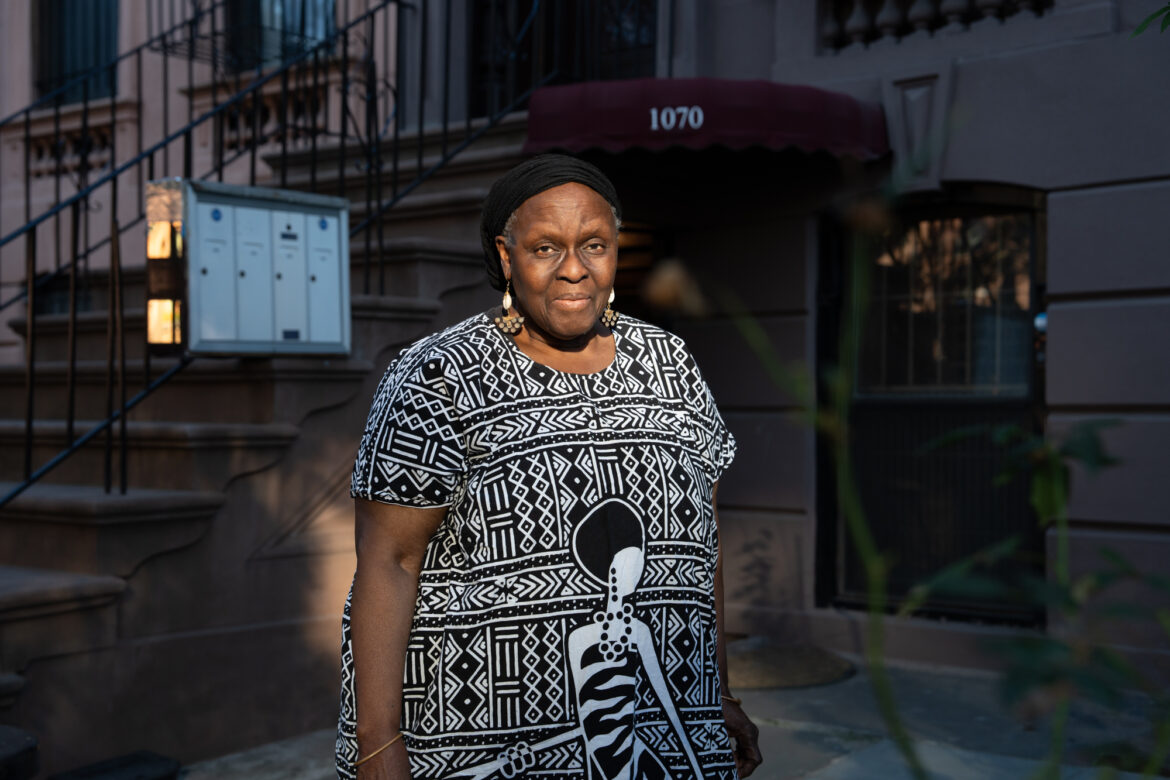
Dana Edwards
Crown Heights resident Betty Davis in her front yard on Dean Street. This year she has received $930 in fines from the Department of Health and Mental Hygiene for rodent activity. She says the fines are frivolous.
When Mayor Eric Adams took office nearly three years ago, he made it his personal mission to solve New York City’s seemingly intractable rat problem. “I hate rats, and I’m looking to kill and get rid of rats in the city,” he said in December 2022 after signing four rat-focused bills into law.
Two years into the anti-rodent siege, widespread rat infestations persist, but one consequence of the policy change has emerged: a major uptick in homeowner fines.
Citywide, the number of rodent-related summonses issued by the Department of Health and Mental Hygiene (DOHMH) doubled between 2021 and 2022, the year Adams became mayor, and has since remained relatively constant. The annual rate since 2022 is also almost double pre-pandemic levels, with 30,452 violations doled out in 2023 and 27,968 so far this year, as of Nov. 14.
The uptick in fines does not appear to have led to an overall reduction in citywide rodent activity. 311 complaints are the metric most commonly cited by city officials to track the severity of infestations, and calls about rat sightings and conditions attracting rodents have actually increased slightly since Adams took office and enforcement picked up.
But rat populations are not evenly distributed. The 2022 legislation identified four areas with particularly severe rat problems and designated them “Rodent Mitigation Zones” (RMZs), which are home to about 1 million New Yorkers. The RMZs—one in Harlem, one in the Bronx, one in the Lower East Side and Chinatown, and one in Central Brooklyn—encompass lower-income neighborhoods, including areas with predominantly Black and Latino populations.
Adams and his newly appointed “Rat Czar,” Kathleen Corradi, acknowledged these demographics when the RMZs were established in April 2023, framing the rodent-reduction efforts as a matter of equity. The laws were supposed to be a way to help under-resourced communities that have struggled with persistent rat infestations.
Instead, homeowners in those areas are bearing the cost, a City Limits’ analysis of violations data shows. Brooklyn’s zone saw a particularly sharp uptick in DOHMH fines after the RMZs were established in mid-2023, on top of the already elevated level of citywide enforcement. The agency issued 3,073 rodent-related summonses in the Brooklyn zone in the six-month period ending Dec. 31, 2023 (the most recent period for which RMZ-level violation data is available), a 63 percent increase from the preceding six months, according to data provided by DOHMH.
Zip code 11216, which straddles Bed-Stuy and Crown Heights within Brooklyn’s RMZ, received one rodent-related summons for every 27 residents in 2023, more than 10 times the citywide average of one fine for every 289 residents, according to Office of Administrative Trials and Hearings (OATH) records. This is the highest per-capita rate of every zip code in the city, though all RMZ zip codes have violation rates above the city’s average, ranging from one fine for every 27 residents to one fine for every 228 residents in 2023.
One block within zip code 11216, located on Dean Street between Franklin and Bedford avenues in Crown Heights, has seen a particularly precipitous uptick. It received five rodent-related fines in 2019. In 2023, it received 35, a 600 percent increase in four years.
“The summonses started escalating,” said Betty Davis, an 80-year-old retired homeowner on the Crown Heights block in question. “And they are frivolous. You could get three and four summonses for the exact same thing before you had a chance to comply.”
The fines are also expensive. They start at $300 and go up to $2,000 for repeat offenses. Davis has been charged $930 this year alone.
There are several types of rodent violations issued by DOHMH, but one of the most common, NYC Health Code 151.02(a), cites a “failure to eliminate rodent infestation shown by active rodent signs.” Some residents of the block say it’s unfair to be held accountable for signs of an infestation they couldn’t possibly control. They instead see themselves as victims of the problem, and if anything, they demand compensation for damage to their property.
“The rats were invading us,” Davis said. “And the city is depriving us of funds.”
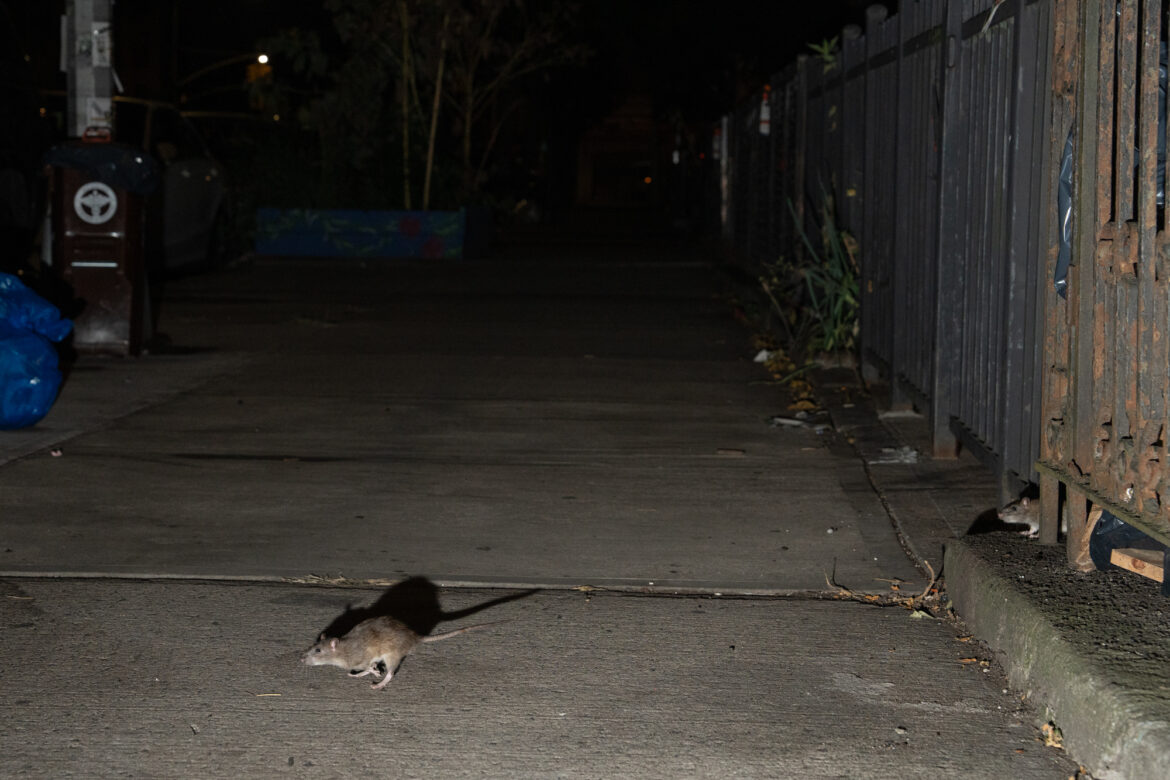
Dana Edwards
Rats dart across the sidewalk outside of 988 Bergen St. on Oct. 13, 2024. The area is experiencing a severe rodent infestation.
On a walk down Davis’ block on Dean Street one recent October night, rats could be heard rustling in nearly every trash bag awaiting collection on the curb—though they seemed uninterested in the rodent bait boxes dotting the sidewalk. They could be seen scurrying in front yards, poking their heads out from behind gates and from underneath parked cars. About every minute, one or two darted across the street.
Davis said the infestation on her block exploded after the city contracted National Grid to excavate the sidewalk and street to install a new gas line for a high-rise rental development at 1040 Dean St., called “The Dean.”
“That was it, that cooked us,” Davis said. “There was no way we could stop the rats after that, because it meant they tore up the streets. They went underground to the gas pipes, and they disturbed everything.”
A number of other residential projects have been built within a few block radius of her home in recent years, with still more under construction. The neighbors say the sites have served as breeding grounds for rats, especially during periods when they lay vacant for months.
Laura Poynter, a homeowner on the other side of Davis’ block, along Bergen Street, also pointed specifically to The Dean, as well as a recently-completed high-rise at 954 Bergen St., as two of the worst offenders. “They started really digging and leaving the site empty,” Poynter said, referring to construction at 954 Bergen St., a 36-unit condo building, according to its website. “Then it got really bad. Really, really bad.”
One of the city’s 2023 rodent laws sought to mitigate the problem in construction sites. City Law 442-A requires most developers to hire an exterminator for a building site before receiving a permit to break ground.
But the developments in question began construction before the law went into effect, and it’s unclear if the developers took preventative measures of their own accord. Poynter doubts it. “They don’t lay rat poison. They don’t do anything,” she said.
The owner of 1040 Dean St., as well as the general contractor that built the building—Brooklyn GC LLC—did not respond to multiple requests for comment. The owner of 954 Bergen St. could not be reached.
According to NYC’s Office of Administrative Trials and Hearings (OATH) records, neither The Dean nor 954 Bergen St. has received a single rodent-related summons since construction began. OATH records confirmed that Davis, Poynter, and their neighbors, on the other hand, have paid thousands of dollars in fines.
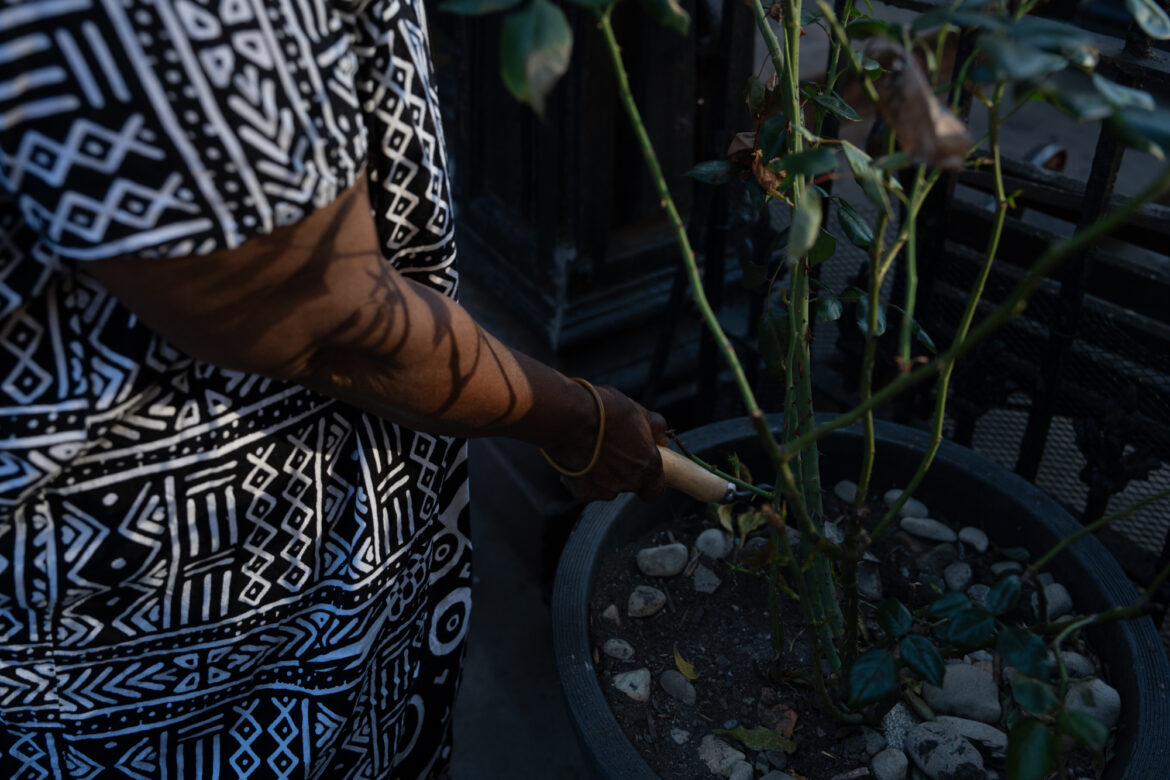
Dana Edwards
Crown Heights resident Betty Davis tends to her potted plants in her front yard. She was forced to remove her large garden after receiving multiple fines from DOHMH for rodent activity.
Davis used to pride herself on her stoop-side garden of lilies, roses, and peppermint. She specifically planted the peppermint for its rodent-deterrent scent. But after receiving a summons in 2021 for a rat hole in the side of the planter bed, she was forced to remove the garden.
The DOHMH inspector told her that she could instead garden in potted plants raised on cinder blocks, so she switched to pots. But when an inspector returned this past March to find fresh rat droppings on the pavement where her garden used to be, she received another $300 fine. And then another $630 fine in July.
By all accounts, rats had visited her front yard, but it’s unclear that she had personally done anything to invite them. “What can I do to make this stop?” Davis said. “There’s no way you can hold an individual homeowner accountable for that.”
Poynter, for her part, received a DOHMH summons for a hole in her wrought-iron gate, which by design contains holes and is in no way intended to keep out rats. “It’s a gate,” she said. “I mean, there wasn’t a hole in the pole, but that’s what they wrote it for.” She was fined $600.
Residents aren’t just paying hefty fines; they’re also shelling out to comply with the summonses’ demands. Davis has paid thousands of dollars to private exterminators. Many neighbors have been forced to pave over their dirt yards and—like Davis—to destroy their gardens in order to comply. “I deserve my flowers,” Davis said.

Photo by Ralph Poynter. Provided by Betty Davis.
Betty Davis stands next to her garden in 2016. She was forced to remove the planter beds earlier this year because of rat activity.
Residents like Poynter and Davis feel the fines are too much to bear on top of those other burdens, not to mention the health risks and sheer “ick”-factor associated with living around so many rats. They feel that they’re doing everything right, and yet the summonses keep coming.
But some neighbors, Poynter said, are indeed contributing to the problem. “It’s like, if you fix yours, that’s great, but the rats will still come through,” Poynter said. “Everybody’s got to get it together.”
Rashida Richardson, a lawyer and homeowner on Poynter’s block, agreed that not every homeowner is as proactive as Poynter and Davis. The problem, she said, is that the fines aren’t only targeted at those at fault. Instead, she says, DOHMH fines indiscriminately on the block in what she feels amounts to a form of collective punishment.
The main offenders are new construction and certain homes owned by out-of-town investors, according to Richardson. Her neighboring building, 997 Bergen St.—which was purchased by a management company in 2014—has a particularly bad infestation, with many visible rat burrows in its dirt yard. The landlord at 997 Bergen St. has been fined five times since 2022 for failing to address the rodent activity; Richardson has been fined for it as well.
Two years ago, she called 311 to complain about her neighbor’s rat problem, which was spilling over into her yard. When an inspector arrived, they fined her $300 for rat droppings barely across her property line, from rats that she says live next door. The summons cited the same “failure to eliminate a rodent infestation” code that was in the tickets Poynter and Davis received. (The owner of 997 Bergen St. did not respond to multiple requests for comment.)
Residents in Queens have also reported being fined after making 311 complaints about rodent activity. “Unless we sweep like four times a day, you’re going to find some evidence of the infestation,” Richardson said.
DOHMH officials, and members of the mayor’s office, did not make themselves available for an interview after multiple requests, nor did they respond to emailed questions about the Crown Heights residents’ concerns.
“Everyone has a role to play in keeping our communities free of pests and rodents. The Health Department works collaboratively with community members to fix conditions that lead to increased rats,” Caroline Bragdon, director of neighborhood interventions for Pest Control Services—a department of DOHMH—wrote in an email to City Limits. “That includes hosting Rat Academy sessions, recruiting everyday residents to join the Rat Pack or issuing orders to correct conditions before they lead to violations.”
According to the DOHMH website, the process is supposed to go something like this: DOHMH employees conduct initial inspections, either proactively or in response to 311 calls. If a property fails inspection due to active rodent signs or conditions that harbor rats, they issue an abatement order. They then return in two to three weeks for a compliance inspection. If the problem remains, the homeowner is issued a summons that compels them to pay and make certain changes.
In other words, property owners are supposed to receive a warning before being fined, giving them an opportunity to correct the issue. The website also mentions that DOHMH provides technical assistance to those in violation. DOHMH may additionally send exterminators to the property to apply rat poison, which the owner is charged for.
Richardson, however, said that she didn’t receive a warning for her 2022 violation, and she didn’t receive anything in the way of technical assistance. She has complained repeatedly to the landlord of 997 Bergen St. and to DOHMH, imploring them to do something about the infestation other than fining her, but to no avail. In March 2024 she received another $300 fine for rodent activity that she says originated in her neighbor’s yard.
The actions, or inaction, of building owners are one ingredient in the morass that is the neighborhood’s infestation. But the elephant in the room may be the trash bags that do little to obstruct the rats from their nightly buffet. Regardless of how conscientious individual residents are about taking bags out at the right times, rats have a field day with trash bags in an area as infested as Dean Street.
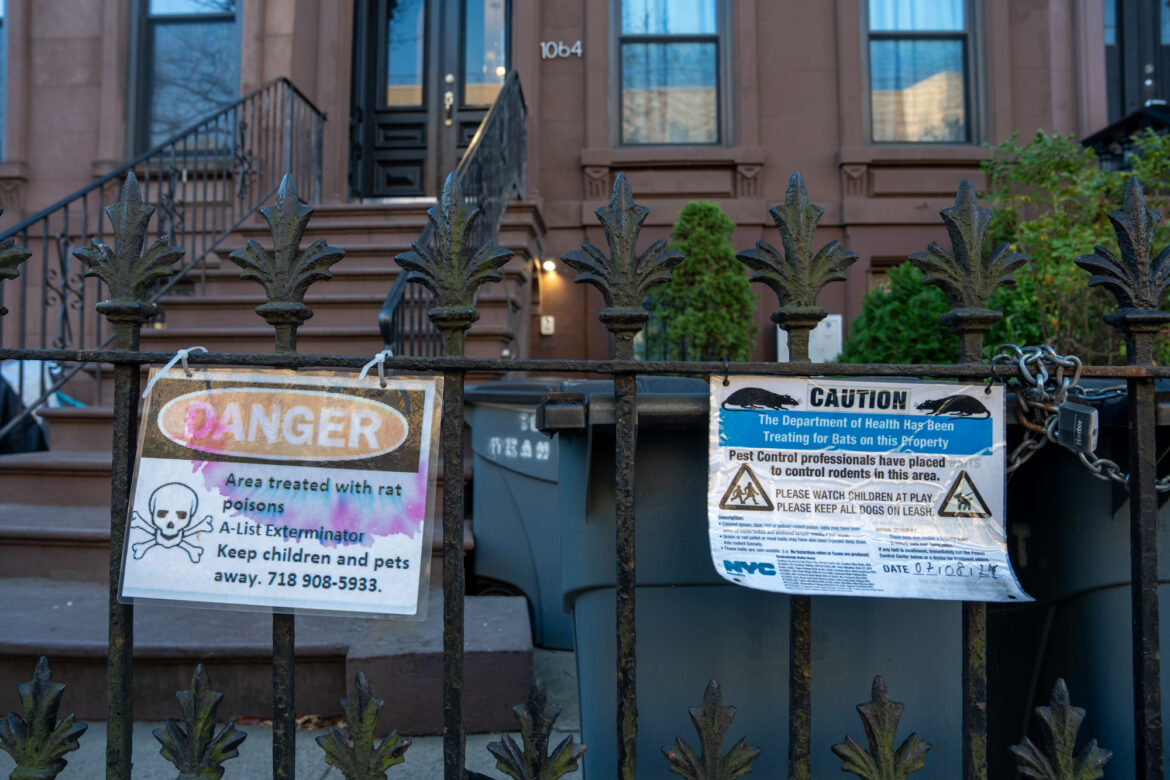
Dana Edwards
Signs along Dean Street warn of rat poison. The Department of Health and Mental Hygiene sends exterminators to apply the poison after homeowners are found in violation of health code.
A lack of bins plays a huge role in the rodent problem not just in Crown Heights, but citywide. Dr. Michael Parsons, one of the world’s few scientists with a PhD in urban rodentology, has commented extensively on the city’s mitigation efforts. He says that eliminating access to garbage as a food source via rodent-proof bins is the most impactful factor in reducing infestations, and he’s been critical of other strategies, like rat poison.
“Small populations of rats can actually manage themselves,” Parsons said in a 2021 interview with Mongabay, a conservation news site. “If there are limited food resources, they’ll be very, very territorial.”
“But they have no reason to manage themselves if it’s like, ‘Hey, join the party. There’s plenty of food here. Beer and pizza to go around, knock yourself out,’” Parsons said in the same interview.
A new Department of Sanitation policy, championed by Mayor Adams, requires all properties with under 10 units to use rat-proof trash bins. The city has begun selling official “NYC Bins” at a steep discount to help residents meet the mandate, which went into effect on Nov. 12.
And there are yet other factors in play beyond bins in the Crown Heights neighborhood. Davis and Poynter said that a few years ago, their block was home to several dozen feral cats who helped keep the rat population in check. But when new neighbors brought the cats to animal shelters (against the will of the longtime residents), the rats multiplied. That roughly coincided with the gas line excavation, creating a perfect storm that exploded the rodent population.
In a city as dense and dynamic as New York, acute rodent infestations tend to have myriad causes. It’s hard to say who’s most at fault for the neighborhood’s problem—the city, local developers, the vigilante cat rescuers, or certain negligent residents and landlords—but blame games aside, two troubling facts remain: Homeowners in RMZs are disproportionately burdened with expensive summonses.
And, as members of predominantly low-income communities of color, many of those homeowners are the least financially equipped to afford the fines. “It’s like what they do is fine the people who really can’t pay,” Poynter said.
By comparison, residents of more affluent and predominantly white Park Slope, less than two miles away from Davis’ block and outside the RMZ, are hardly ever issued fines for rodent activity. Most blocks in Park Slope have received between zero and two rodent-related summonses since 2018, while Davis’ block alone has accrued 112, according to OATH records.
Davis’ zip code, 11216, has received nearly 10 times the number of rodent-related fines from DOHMH since 2018 as zip code 11215, which encompasses Park Slope and Gowanus (8435 fines compared to 866), but only 1.5 times the number of rodent-related 311 requests. What’s more, the Park Slope zip code has a population that’s 16 percent higher than Davis’.
Richardson views this inequity within the broader context of gentrification in Crown Heights. “Part of the root cause here is all of the development,” Richardson said. She, Davis, and Poynter are all Black, multigenerational homeowners in a neighborhood with a shrinking Black population and skyrocketing rents. Crown Heights was 78 percent Black in 2000. Now it’s only 44 percent.
Richardson interprets the fines as yet another attempt to push her out of the brownstone her family has lived in since her grandparents purchased it in the 1930s—in order to make room for expensive condos or rentals.
“The fines are a way to displace people,” Richardson said. “The real issue is big money, big real estate; they get tax write-offs and make millions off of these buildings that aren’t even full because they’re not affordable, and they aren’t required to do anything to deal with the rat issues that are the result of their construction.”
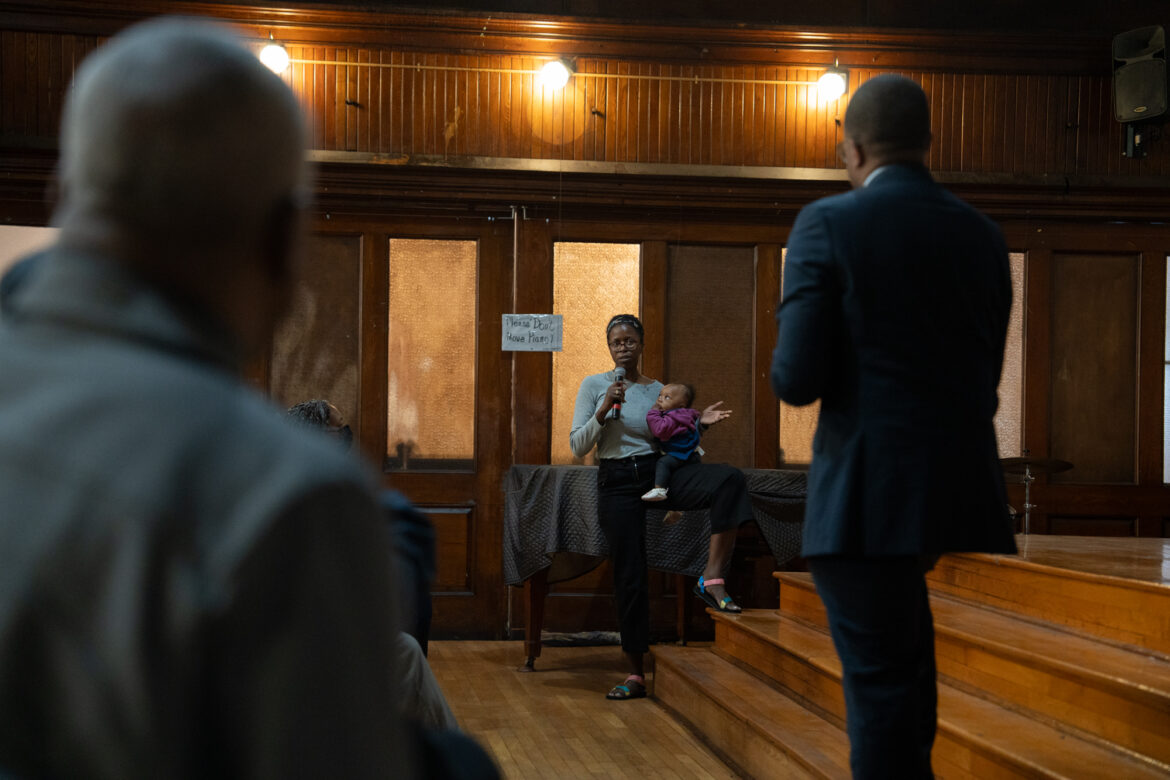
Dana Edwards
Crown Heights resident Rashida Richardson addresses State Sen. Zellnor Myrie at a homeowners’ forum at the Bedford Central Presbyterian Church on Sept, 29, 2024. Richardson and other attendees asked Myrie to help them address the uptick in summonses.
Both Richardson and Davis have attempted to fight back against the fines. Richardson appealed her latest summons, arguing to OATH that she had been proactive in rodent prevention on her property—she paid thousands of dollars to exterminators and to have her yard paved over, and she attended DOHMH’s “NYC Rat Academy” training. She argued that the fine should be waived, citing a DOHMH appeals precedent that established that residents “taking adequate measures to prevent and control pests” can mount a defense against summonses. Her appeal was denied in July.
After receiving her latest fine, Davis plastered posters around the neighborhood decrying a “summonses blitz” and declaring a pattern of “new age blockbusting.” As vice president and secretary of the Dean Street Grant Square Block Association, a Black homeowners group, she organized a forum at a local church on Sept. 29 for neighbors to voice their concerns to State Senator Zellnor Myrie, who led the forum. Several members of the block association spoke to the group about receiving rodent-related summonses that they view as unfair. Sen. Myrie—who is running for mayor against Adams—lent a sympathetic ear.
“I think there is a historical through-line with redlining and what we’re seeing today,” he said after the Sept. 29 meeting, referring to the uptick in DOHMH fines and to another threat confronting Black homeowners in the area: deed theft. Myrie authored a law addressing deed theft that went into effect in July.
“We have seen in the past that Black New Yorkers were confined to certain areas and spaces where they could live, and those were the only spaces that they could live,” Sen. Myrie said. “And now we see those very neighborhoods are pushing them out because of the changing dynamics and the upping of property value.”
Davis echoed Myrie’s concerns. “We are constantly inundated and bullied to sell our property,” she said. “These fines are just another way to make us leave.”
In her efforts to seek help from elected officials, Davis’ primary demands are twofold: she wants the city to stop what she believes are unfair fines, and she wants them to actually address the rat problem. She says the city is just passing the buck to residents like her who are victims of the infestation.
After trying for months in vain to arrange an OATH hearing to plead her case, Davis approached her City Councilmember, Crystal Hudson, for help. Hudson’s office helped her set up an OATH hearing on Oct. 25 in which she contested her $300 summons from March. (Davis believes the homeowners’ forum with Sen. Myrie may have also influenced OATH officials.)
OATH records state the result as “dismissed” on Oct. 30, but almost three weeks later, Davis said she hasn’t received any notice about the dismissal, and she expressed skepticism that she wouldn’t end up having to pay. She has another hearing on April 3, 2025, in which she will contest her latest $630 fine.
Richardson—who as a practicing attorney was unable to overturn her own fines, even when she cited relevant case law—is not optimistic about Davis’ chances.
“Homeowners are left on the hook as if it’s our problem, when really, we can see what the problem is, and those people are not held accountable,” Richardson said.
To reach the editor, contact Jeanmarie@citylimits.org
Want to republish this story? Find City Limits’ reprint policy here.














